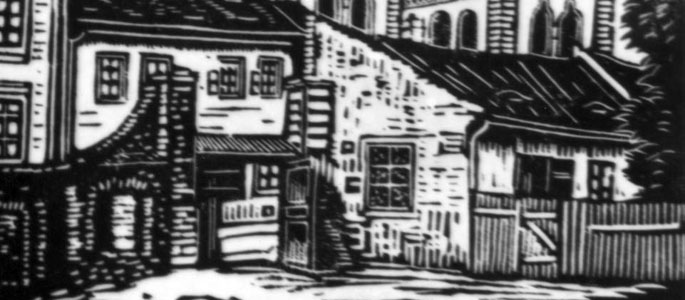Bratislava Before the Holocaust
Religious Life
Documents from the 13th century mention the Jewish community of Bratislava (then called Pressburg). The name of the city’s rabbi – Rabbi Yehuda Liberman – is noted, as well as the names of Jews from the city who were killed or burnt at the stake during the crusades, among them Rabbi Yonah ben Rabbi Shaul and his students. During the 14th century the community numbered several hundred Jews; it had a synagogue, a cemetery, a mikveh (ritual bath), and other public institutions.
At the end of the 17th century the city’s chief rabbi was Rabbi Yom-Tov Lipmann. The Great Synagogue was located in the Zuckermandel quarter. In 1708 the community maintained two synagogues, one of which was located in the Schlossberg quarter. During the 18th century this synagogue was renovated and expanded twice, but ultimately it was destroyed in a fire. In its place, prayer rooms were opened throughout the Schlossberg quarter; these prayer rooms existed until the destruction of the Bratislava community during the Holocaust. The Jewish community in the city also operated a mikveh, a hospital, kosher butcher shops and an inn for Jewish wayfarers. The community further boasted a cheder (or Jewish elementary school) and a talmud torah (after hours supplementary religious school). At the behest of the community elder, Shimon Michael, a beit midrash (religious study hall) was created, as well as other public institutions.
It seems that the Chevra Kadisha (Jewish burial society) was founded in Bratislava as early as 1689; the members of this institution were respected by the community thanks to the charitable foundations which they operated. Other charitable institutions operated alongside the Chevra Kadisha. On the outskirts of the city a Jewish cemetery was erected. At the time of its closing, in 1847, it held some 6,000 graves.
During the 18th century the small Jewish community of Bratislava made important strides. It became an important center for Jewish learning in Central Europe, and was home to a yeshiva. At the beginning of the 19th century famous rabbis made the city their home, and the rabbinical institutions operating in Bratislava gave the city a reputation as the most important center for Jewish learning in all of Central Europe. The highpoint of this activity came between 1806 and 1839, under the leadership of the Chatam Sofer, head of the Pressburg Yeshiva.
In 1872, when the community was led by Rabbi Samuel Benjamin Sofer, the grandson of the Chatam Sofer, a split developed in the community. The larger segment remained within the Orthodox community, which retained control over the community’s institutions. The much smaller Neolog community, led by William Frankl, found itself without institutions and had to develop its own infrastructural network. The Neologs established their own Chevra Kadisha, as well as a separate cemetery and charitable foundations. In 1895 the Neolog community opened their own synagogue in Bratislava, replacing the makeshift prayer rooms which had served for worship before that time. Toward the end of the 19th century the Neolog community experienced constant growth and developed numerous public institutions.
At its height Bratislava was home to some of the most important rabbis in Central European Jewry. For generations the city was noted as a center for Jewish learning, and the most important rabbinical center of its day. Between 1830 and 1930 some 350 rabbinic works were published in Bratislava.
Government of the Federal Republic of Germany








